- Home
- The Spring Garden
- Spring Perennials A-D
Spring Perennials Provide Some of the Chief Glories of the Garden
The list of spring perennials is long and contains some of the most charming and beloved plants of all.
Adonis amurensis, Amur adonis, Zones 4-7. One of the first perennials to bloom in spring, adonis carpets the ground with soft, ferny foliage and bright buttercup yellow blooms brownish-red sepals. Great as a woodland ground cover.
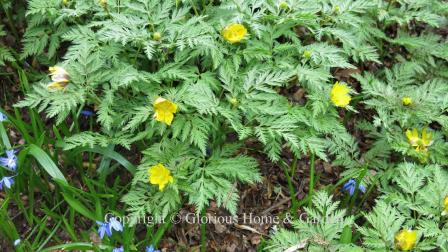 Adonis amurensis
Adonis amurensisAjuga reptans, bugle weed or carpet bugle, Zones 3-9. A lovely and useful ground cover, ajuga will quickly grow into a low dense mat of green and purple foliage with spikes of violet flowers in spring. Weeds have a hard time competing with the density of ajuga. It does well in partial shade, and thus is nice for underplanting shrubbery. Beware the tendency to invade lawns, however, due to its stoloniferous roots. If that occurs, it is easy enough to dig up the travelers and plant them elsewhere. There are some excellent cultivars on the market. 'Black Scallop' has very dark burgundy, almost black foliage, 'Burgundy Glow; has striking variegated foliage in green, rose, purple and white with the typical blue flowers; 'Caitlin's Giant' sports larger leaves and taller (up to 10") flower spikes, 'Chocolate Chip' has smaller, dainty leaves, and 'Silver Beauty' has variegated green and white foliage.
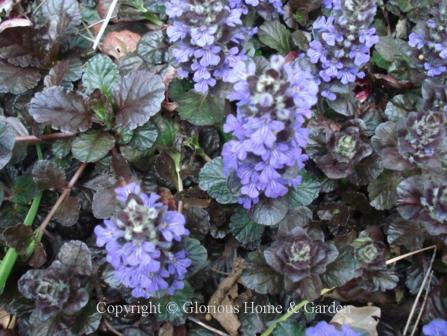 Ajuga reptans 'Black Scallop'
Ajuga reptans 'Black Scallop'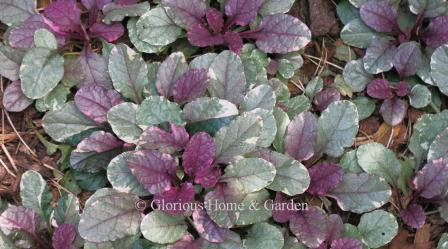 Ajuga reptans 'Burgundy Glow'
Ajuga reptans 'Burgundy Glow'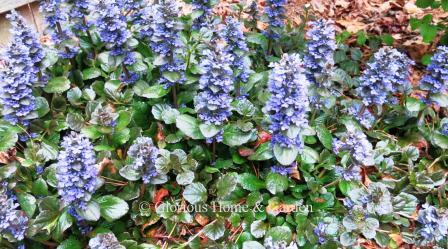 Ajuga reptans 'Caitlin's Giant'
Ajuga reptans 'Caitlin's Giant'Alchemilla mollis, Lady's mantle, Zones 4-7. The soft, fuzzy, pleated leaves contrasting
with sprays of yellow-green flowers make for a beautiful ground cover where
they can be grown successfully. But as
they prefer the cooler temperatures and moisture of more northern climes, they
don't do well in my hot, often dry, 7b garden.
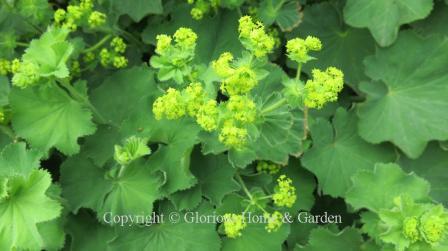 Alchemilla mollis
Alchemilla mollisAmsonia hubrichtii, Arkansas amsonia, Zones 6-9. I finally tried my first amsonia a couple of years ago after reading about its qualities for years, and I have been very impressed. Amsonia hubrichtii is a useful filler in the garden with its soft, feathery foliage, and in spring is topped with small pale blue star-shaped flowers. My clumps have increased every year, and I love the show it puts on the autumn when the leaves turn to gold. Perennial Plant of the Year for 2011.
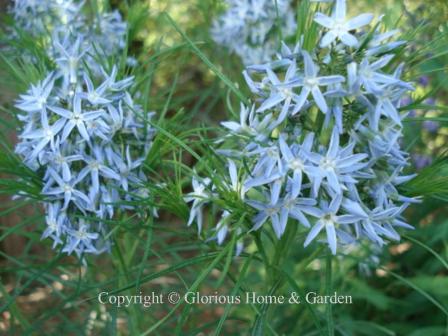 Amsonia hubrichtii
Amsonia hubrichtiiAmsonia tabernaemontana var. silicifolia, blue star, Zones 3-9. Another American native, this species has longer, wider leaves than A. hubrichtii, but also has blue flowers in spring and golden foliage in the fall.
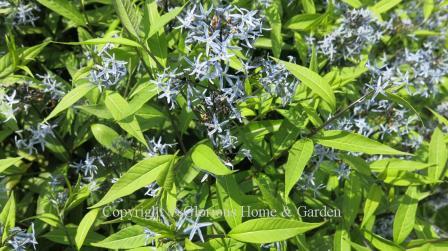 Amsonia tabernaemontana var. salicifolia
Amsonia tabernaemontana var. salicifoliaAnthriscus sylvestris, cow parsley or wild chervil, Zones 7-10. Cow parsley is a common countryside wildflower in England in late spring and early summer when it seems every lane is lined with a froth of lacy white. This biennial or short-lived perennial has been naturalized in much of North America. Lovely to use as a filler plant in a mixed border, cow parsley will self-seed where happy. ‘Ravenswing’ is a striking cultivar with dark stems and foliage that make a nice contrast with the white flowers
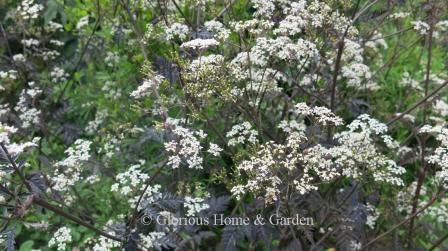 Anthriscus sylvestris 'Ravenswing'
Anthriscus sylvestris 'Ravenswing'Columbines
Aquilegia canadensis, Canadian columbine, Zones 3-8. This native columbine is a lovely addition to the shady border. On their thin, wiry stems they often seem suspended in air and glow like little lanterns of red and gold. A lovely spring perennial combined in the border with others like species tulips, pheasant eye narcissus, wood hyacinths, violas and wallflowers. They will self-sow, or you can collect the ripe seeds to plant them around the garden where you will. Great hummingbird and butterfly attractant.
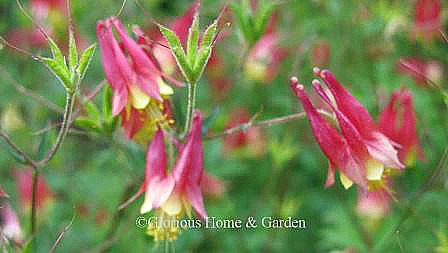 Aquilegia canadensis
Aquilegia canadensisAquilegia chrysantha, golden columbine, Zones 4-8. This is another North American columbine native to the southwestern U.S. and Mexico. The large bright yellow flowers are very striking in the garden.
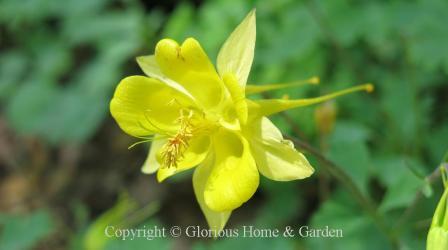 Aquilegia chrysantha
Aquilegia chrysanthaAquilegia X hybrida, hybrid columbine, Zones 3-9. The beautiful long-spurred hybrid columbines are some of my favorites in the spring garden. Their delicate airiness blends well with other plants. It's not always easy to find them in nurseries, but they are easy to grow from seed started indoors in late winter, or directly in the garden when danger of frost is past. Then you can have plenty to place where you will in the garden. 'Mrs. Scott Elliot' is a lovely old strain with long spurs in bicolor combinations of white, yellow, rose, lavender and blue. Other strains to look for are the McKana Hybrids, Origami Hybrids and the Songbird Series. 'Origami Blue and White' is shown below.
The nemesis of columbines is leaf miner which is a fly that lays its eggs on the new leaves. The emerging larvae eat tunnels through the leaves leaving ugly, unsightly tracks. If leaf miner is a problem, about the only remedy is to cut back the foliage after blooming is finished and a new spurt of growth will appear.
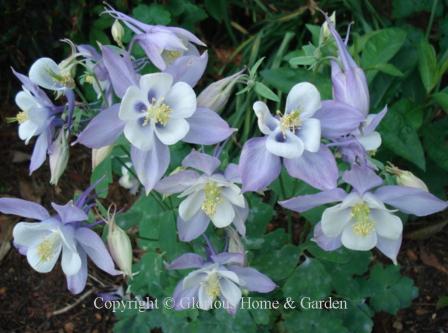 Aquilegia 'Origami Blue & White'
Aquilegia 'Origami Blue & White'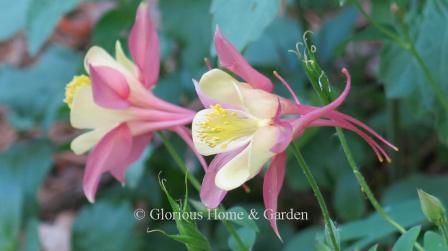 Aquilegia 'Swan Pink and Yellow'
Aquilegia 'Swan Pink and Yellow'Aquilegia vulgaris var. stellata clematis-flowered columbine, Zones 3-8. These delightful columbines have multi-petaled spurless nodding flowers produced over several weeks in the garden in shades of white, rose, blue and purple. Easy to grow from seed, and in fact will self-sow, so even though the individual plants are not particularly long-lived, new generations will follow. ‘Blue Barlow,’ ‘Nora Barlow,’ 'Clematiflora,' are some particularly lovely cultivars. ‘Clemantiflora’ is not to be confused with the "Clementine" series which are similar, but have upright facing flowers.
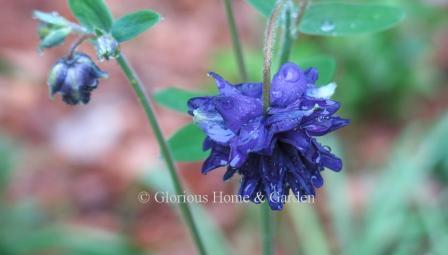 Aquilegia vulgaris var. stellata 'Blue Barlow'
Aquilegia vulgaris var. stellata 'Blue Barlow' Aquilegia vulgaris 'Clematiflora'
Aquilegia vulgaris 'Clematiflora'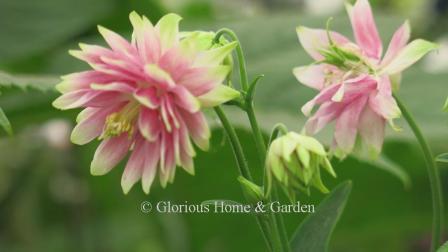 Aquilegia vulgaris var. stellata 'Nora Barlow'
Aquilegia vulgaris var. stellata 'Nora Barlow'Aruncus dioicus, goat's beard, Zones 3-7. Goat's beard, a Northeastern native which can grow to 6' tall, is a spectacular plant--if you can provide its preferred growing conditions, i.e., consistent moisture, partial shade, cooler temperatures, and room to spread. Resembling a giant astilbe, the white-to-cream blooms are airier and more pendulous than astilbe. Great plant for a woodland garden or at the back of a partially shady border.
Baptisia australis, false blue indigo, Zones 3-8. One of our native plants that is growing is popularity is baptisia, or false indigo. It seems to have an oxymoronish sort of common name given that indigo is so strongly associated with blue. Well, it is false indigo after all, though B. australis was sometimes used as a substitute for the true indigo plant, Indigofera tinctoria. Nomenclature notwithstanding, this spring perennial forms shrubby clumps with long racemes of blue pea-like flowers. A natural cross of the white species, B. alba with B. australis produced 'Purple Smoke' shown below. 'Ivory Towers' is worth seeking out for its long-lasting white spires.
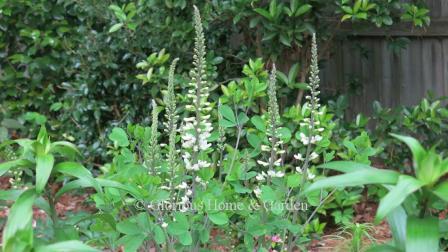 Baptisia x 'Ivory Towers'
Baptisia x 'Ivory Towers'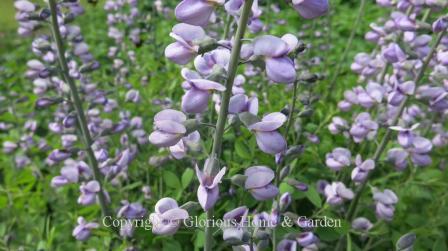 Baptisia 'Purple Smoke'
Baptisia 'Purple Smoke'Baptisia sphaerocarpa, yellow wild indigo, Zones 5-8. Native to the south-central United States, this yellow baptisia is an excellent garden plant as evidenced by the impressive clump at the Daniel Stowe Botanical Gardens below.
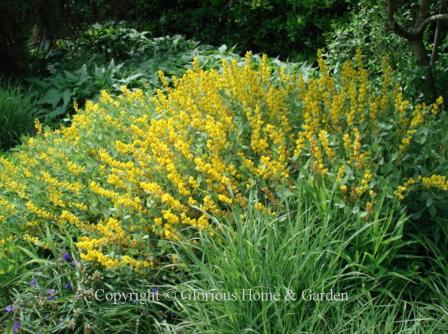 Baptisia sphaerocarpa
Baptisia sphaerocarpaBergenia cordifolia, heart-leaf bergenia, Zones 4-8. Mostly grown for its foliage, bergenia has thick, leathery, heart-shaped leaves that make a nice ground cover for moist, shady areas. The leaves tend to turn burgundy red in winter, but are often tattered and bedraggled by the end of the season. Spring sees a short panicle of small pink to red flower arise from the center of the plant.
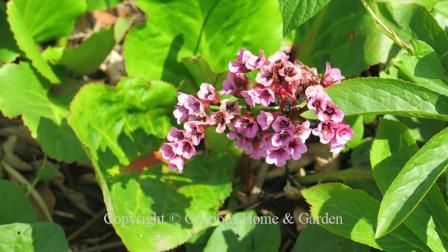 Bergenia cordifolia
Bergenia cordifoliaBrunnera macrophylla, false forget-me-not or Siberian bugloss, Zones 3-8. True blue is one of the rarest colors in the garden and brunnera has some of the most beautiful blues you can find. Perfect for moist, shady locations, brunnera will form clumps from rhizomatous roots to develop into a delightful ground cover. Great to plant for spring bulbs to emerge from as the airy blue sprays will complement the soft yellows, whites or blues of the bulbs and help to hide their withering foliage. Interesting new varieties have been hybridized some with variegated leaves like 'Alexander's Great,' 'Hadspen Cream,' ''Jack Frost,' 'Looking Glass,' 'Silver Heart,' and 'Variegata.'
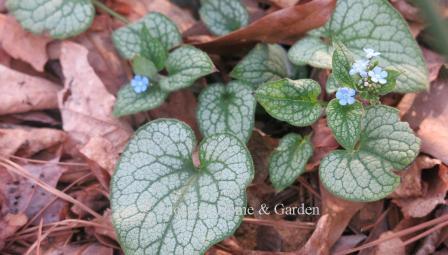 Brunnera macrophylla 'Alexander's Great'
Brunnera macrophylla 'Alexander's Great'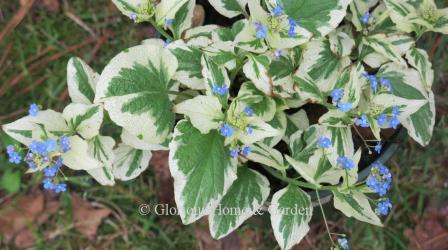 Brunnera macrophylla 'Variegata'
Brunnera macrophylla 'Variegata'Campanula poscharskyana, Serbian bellflower, Zones 3-8. Soft, lilac-blue star-shaped flowers bloom in spring. These are good plants for difficult dry situations. Try them to edge walkways or borders, in rock gardens, or tuck some in chinks of stone walls to cascade down.
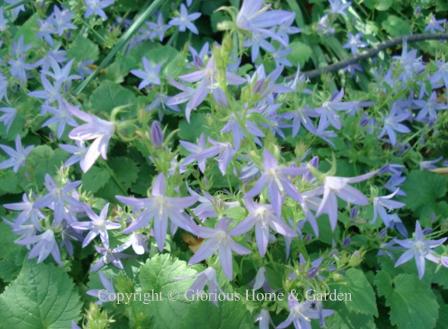 Campanula poscharskyana
Campanula poscharskyanaCentaurea montana, mountain bluet or perennial cornflower, Zones 3-8. Perennial cornflowers are a charming addition to the border, where they will quickly form a colony filling in bare spots due to their stoloniferous nature. The fringe-y blue flowers, some of the purest blues in nature, open in late spring into early summer. There are also white varieties such as ‘Amethyst in Snow’ and purple like ‘Amethyst Dream,’ and 'Jordy.' Grow perennial cornflowers in full sun, average soil with good drainage.
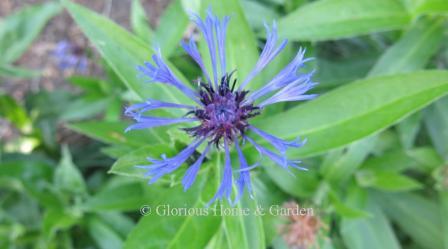 Centaurea montana
Centaurea montana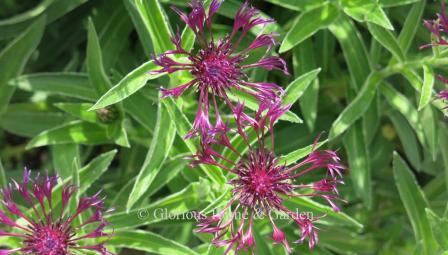 Centaurea montana 'Amethyst Dream'
Centaurea montana 'Amethyst Dream'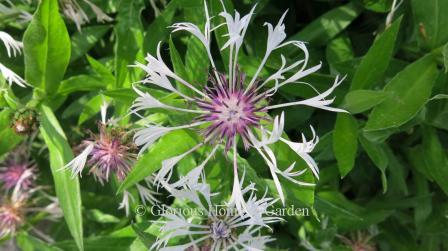 Centaurea montana 'Amethyst in Snow'
Centaurea montana 'Amethyst in Snow'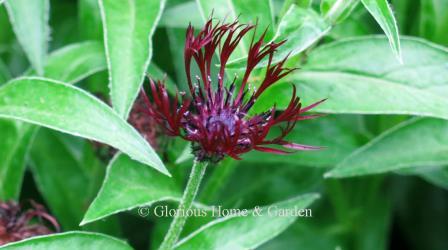 Centaurea montana 'Jordy'
Centaurea montana 'Jordy'Centranthus ruber, red valerian or Jupiter's beard, Zones 5-8. Growing from 1 1/2 to 3' high, this is a good plant for the mid-to-rear of the border. The fragrant rosy pink flowers bloom from mid-spring through most of the summer and will self-seed (thus considered invasive by some).
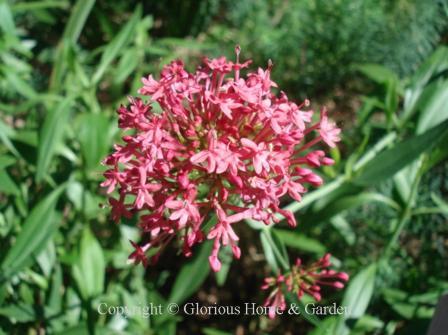 Centranthus ruber
Centranthus ruberDelphinium X elatum, hybrid delphinium, Zones 2-7. Some of the most gorgeous blues in the flower world are found in delphiniums. These tall, stately plants with heavy flowerheads must be staked to prevent breakage, but nothing gives the spring border the height and elegance that the hybrid delphiniums do.
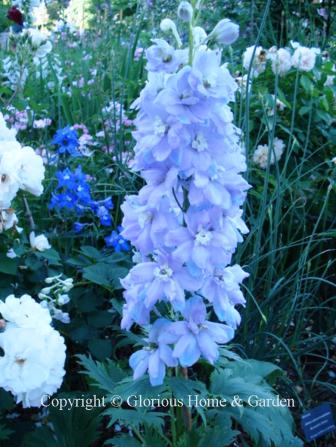 Delphinium x elatum
Delphinium x elatumDianthus or Pinks
Dianthus x allwoodii, Allwood pinks, Zones 4-8. This series of hybrids is well-known for its fragrance from its D. plumarius parentage, long bloom time and larger flowers from its D. caryophyllus (carnation) parentage. Tufts of gray-green foliage topped with fragrant flowers in shades of white, pink, salmon and red make wonderful edging plants for beds and borders. Good drainage is a must to prevent root rot and deadheading will keep them in bloom for a longer period of time. 'Old Spice' (shown below) has fringed, salmon-pink flowers with a lovely clove scent.
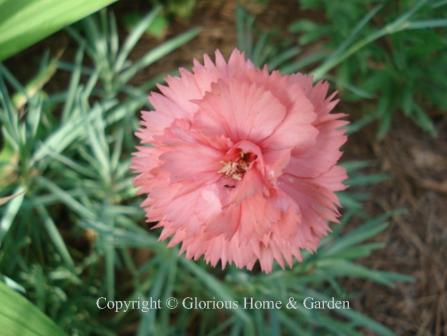 Dianthus x allwoodii 'Old Spice'
Dianthus x allwoodii 'Old Spice'Dianthus caryophyllus, carnation or dianthus, Zones 6-9. Large frilly, double flowers with an intoxicating spicy scent and beautiful colors—what more could you want? These are not florist carnations, but perennial flowers that thrive in the garden or container in full sun and well-drained soil. Besides ‘Magenta+White’ shown, the SuperTrouper™ series also comes in peach, white, yellow, pink, lavender, red, and pink/red and red/white bi-colors.
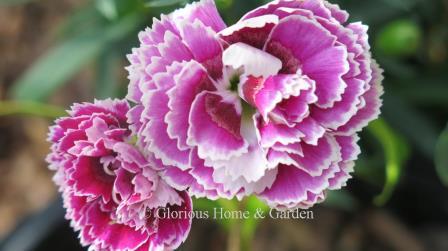 Dianthus SuperTrouper™ 'Magenta+White'
Dianthus SuperTrouper™ 'Magenta+White'Dianthus gratianopolitanus, Cheddar pinks, Zones 3-8. Cheddar pinks have fine, grassy evergreen foliage that forms a neat mound. The bloom period can be extended by deadheading the spent flowers before they go to seed. They are a great spring perennial to use as a filler, or to edge a border. 'Bath's Pink' has pale pink fragrant flowers and is a prolific bloomer. Other good cultivars are 'Firewitch,' with magenta flowers and repeat sporadically in the summer, and 'Tiny Rubies' will small deep pink flowers on short stems rising from and equally petite tuft of foliage.
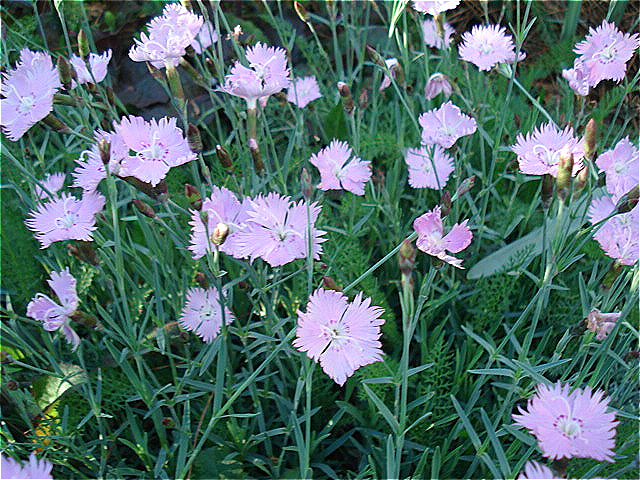 Dianthus gratianopoitanus 'Bath's Pink'
Dianthus gratianopoitanus 'Bath's Pink'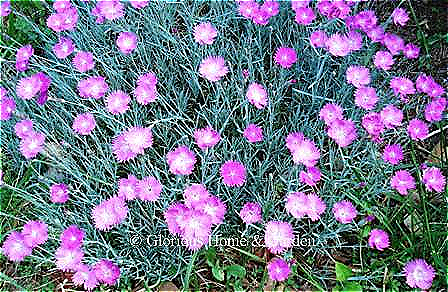 Dianthus gratianopolitanus 'Firewitch'
Dianthus gratianopolitanus 'Firewitch'Dianthus Hybrid Series
There are many series of dianthus on the market creatively hybridized by combining different dianthus species. They share certain traits in common, but there is a lot of diversity within a series. There are so many to choose from that the best course is to just choose ones that have the color or characteristics to best fit your garden.
Here are a few examples.
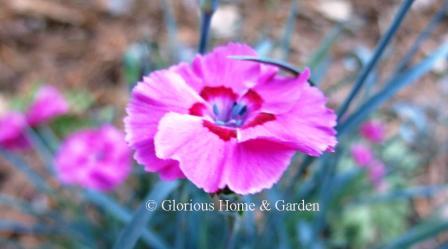 Dianthus 'American Pie® Bumbleberry Pie'
Dianthus 'American Pie® Bumbleberry Pie'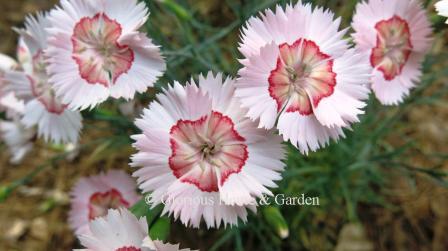 Dianthus 'American Pie® Georgia Peach Pie'
Dianthus 'American Pie® Georgia Peach Pie'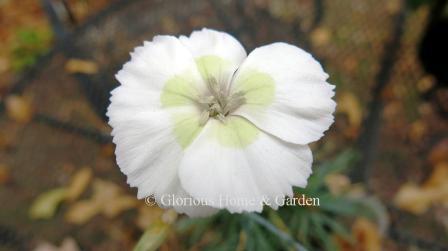 Dianthus 'American Pie® Key Lime Pie'
Dianthus 'American Pie® Key Lime Pie'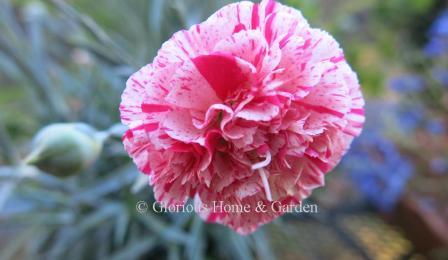 Dianthus 'Devon Cottage™ Pinball Wizard'
Dianthus 'Devon Cottage™ Pinball Wizard'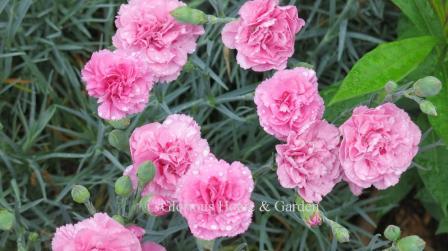 Dianthus 'Devon Cottage™ Rosy Cheeks'
Dianthus 'Devon Cottage™ Rosy Cheeks'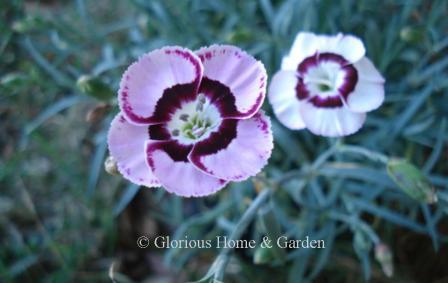 Dianthus 'Dessert™ Series Raspberry Swirl'
Dianthus 'Dessert™ Series Raspberry Swirl'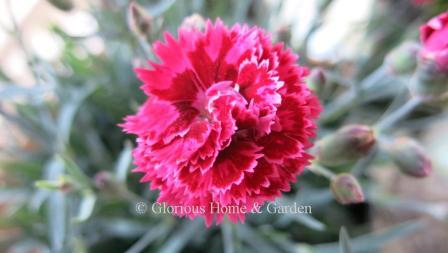 Dianthus 'Fruit Punch® Black Cherry Frost'
Dianthus 'Fruit Punch® Black Cherry Frost'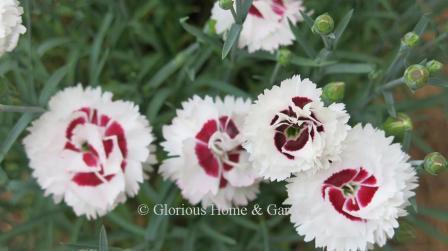 Dianthus 'Scent First® Coconut Surprise
Dianthus 'Scent First® Coconut Surprise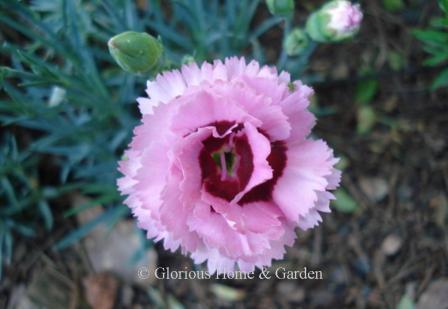 Dianthus 'Scent First® Raspberry Surprise
Dianthus 'Scent First® Raspberry SurpriseDianthus plumarius, cottage, garden, or feather pinks, Zones 3-8. D. plumarius, a European native, is one of the parents of many of today's popular garden pinks. It, and most of its progeny, are characterized by gray-green grassy foliage, deeply cut fringed petals in the usual shades of white, pink, rose, red and combinations on 10" to 18" stems, and strong clove fragrance. 'Mountain Mist' is a hybrid with pale pink fringed flowers on blue-green foliage. 'Birmingham' is a deeply fringed double white; 'Rose de Mai' is pink with a deeper pink eye; 'Musgrave's White' has single blooms with a green eye, and 'Lady Granville' white with a deep raspberry center.
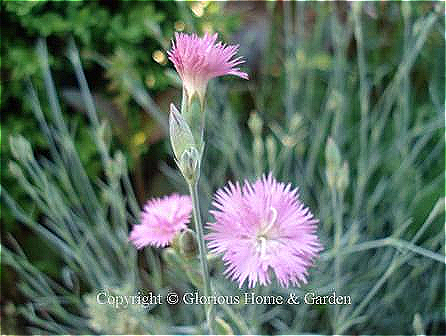 Dianthus plumarius 'Mountain Mist'
Dianthus plumarius 'Mountain Mist'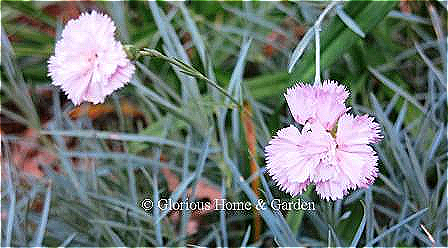 Dianthus plumarius 'Rose de Mai'
Dianthus plumarius 'Rose de Mai'Dicentra eximia, fringed bleeding heart, Zones 3-9. Our native bleeding heart is a lovely plant for the shade garden with its finely cut fern-like foliage and charming flowers of rose or white which are smaller than those of D. spectabilis, but produced in greater abundance and for a much longer time period.
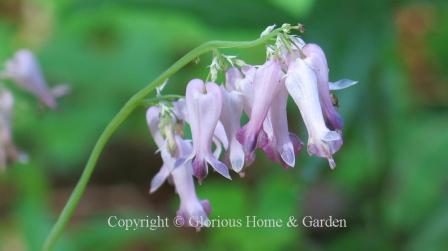 Dicentra eximia
Dicentra eximiaDicentra spectabilis, bleeding heart. See Lamprocapnos spectabilis
Dictamnus albus, gas plant or dittany, Zones 3-7. I remember reading about this plant a long time ago and being fascinated by its apparent ability to produce sparkable fumes from flowers or seedpods. They produce a flammable oil which can be ignited by holding a match to them. I’ve not seen it growing in the South because it prefers cool nights to flourish. However, I did see some at Kiftsgate Court in the Cotswolds, and it is a beautiful plant. Fragrant pink or white flowers are held erect on stiff stems that rise to 3 to 4’. Said to be long-lived and does not like to be disturbed once established. Deer resistant.
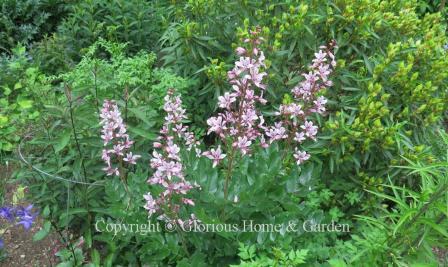 Dictamnus albus
Dictamnus albusFoxgloves
Digitalis grandiflora, yellow foxglove, Zones 4-8. The beauty of yellow foxglove is that as a
true perennial it lasts longer in the border than D. purpurea, and the color gives one added flexibility in planning
color schemes. Like D. purpurea, also poisonous if eaten. Also known as Digitalis ambigua.
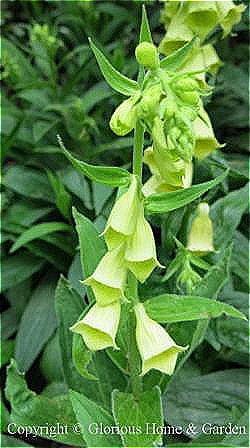 Digitalis grandiflora
Digitalis grandifloraDigitalis purpurea, common foxglove, Zones 4-8. Foxgloves rival delphiniums for the "tall, stately elegance" crown in the spring-to-early summer border. Spires of white, cream, pink, rose, lavender, and purple, often with spotted throats, are very useful to provide height to the spring perennial border. Foxgloves are biennials meaning seeds that sprout one year will bloom the following year, or short-lived perennials, so we often buy established plants at the nursery and treat them as annuals, however they will often re-seed in the garden. The 'Foxy' series will bloom the first year from seed. Usually, you will find mixed colors in series such as 'Foxy,' 'Shirley,' and the giant 'Excelsior' hybrids. Some of the newer hybrids like the Camelot or Dalmatian series can be purchased as separate colors. Be aware that the leaves are poisonous and should be kept away from children and pets—but that also makes them unappealing to deer. The drug digitalis is derived from this plant and is used to treat heart disease.
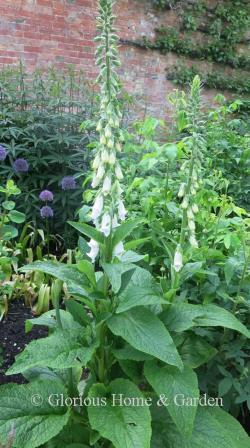 Digitalis purpurea 'Alba'
Digitalis purpurea 'Alba'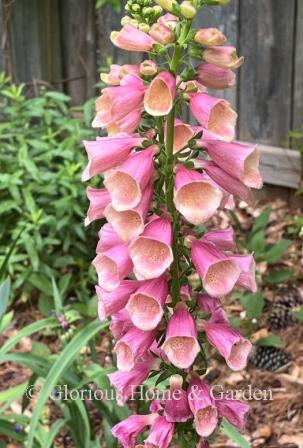 Digitalis x 'Arctic Fox™ Rose'
Digitalis x 'Arctic Fox™ Rose'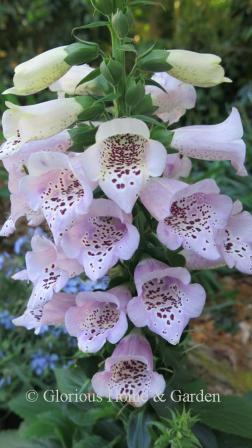 Digitalis purpurea 'Camelot™ Lavender'
Digitalis purpurea 'Camelot™ Lavender'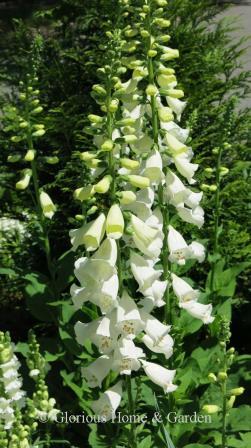 Digitalis purpurea 'Camelot White'
Digitalis purpurea 'Camelot White'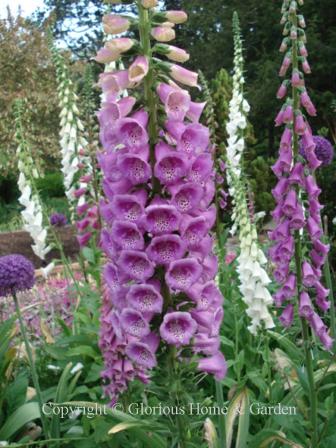 Digitalis purpurea 'Candy Mountain'
Digitalis purpurea 'Candy Mountain'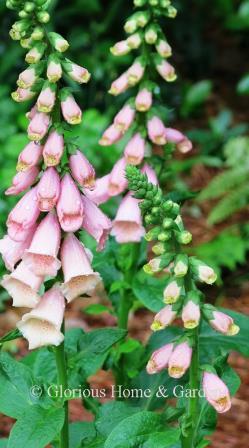 Digitalis purpurea 'Dalmatian Peach'
Digitalis purpurea 'Dalmatian Peach'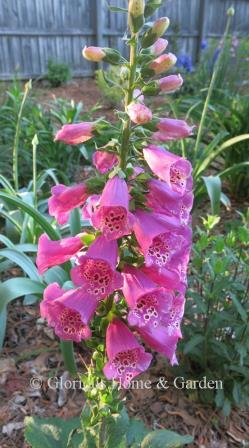 Digitalis purpurea 'Dalmatian Rose'
Digitalis purpurea 'Dalmatian Rose'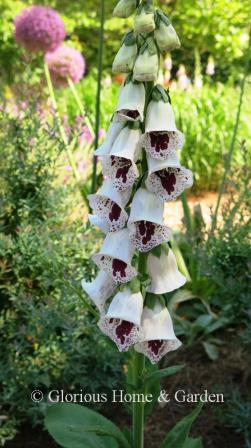 Digitalis 'Pam's Choice'
Digitalis 'Pam's Choice'Digitalis x mertonensis, strawberry foxglove, Zones 3-8. The strawberry foxglove is a hybrid between D. grandiflora and D. purpurea, and combines traits of both parents. It is longer-lasting than D. purpurea, but not as long-lived at D. grandiflora. The individual flowers are large, the soft strawberry pink coloration is unique and the rosette of leaves is attractive in the garden. Still poisonous of course.
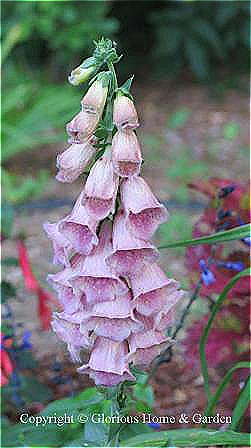 Digitalis x mertonensis
Digitalis x mertonensisReturn to spring perennials E-L.
Return to spring perennials M-Z.
Plant of the Month
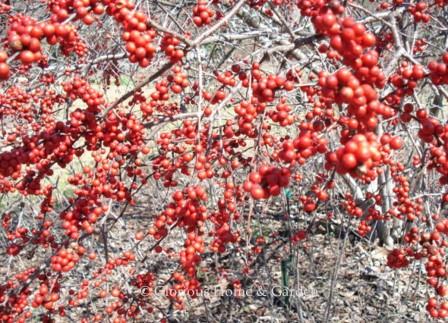
Ilex verticillata
Winterberry holly
Updated new USDA Plant Hardiness Zone Map 2023.